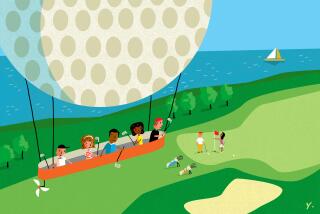Can Golf Control Its Fade? : Industry Works to Boost Ranks and Revenue
The golf industry is gathered in Los Angeles this weekend for one of the sport’s biggest tournaments. But amid the glitz and hoopla of the PGA Championship at the Riviera Country Club, some industry leaders are hoping their sport doesn’t bogey its future.
Golf equipment manufacturers, sporting goods retailers, course owners, top players and other industry leaders want to make sure their sport doesn’t go the way of tennis, which, after peaking in popularity in the late 1970s, has steadily lost participants amid stagnant growth in equipment sales.
Although golf industry leaders can’t seem to agree on whether their sport is gaining or declining in popularity--in part due to conflicting figures on equipment sales and players--they don’t want to take any chances.
Consequently, the sport is undertaking several measures to maintain and renew interest. The sport’s chief trade group will soon launch a public relations campaign to attract more youth and women to the links. To reduce the costs of playing, the industry is opening more small golf courses and driving ranges. Golf equipment makers have introduced several innovations, including oversized clubs, hoping to keep players in the game. And top pros are spending more time teaching children how to play.
Their concern stems from some statistics that appear to show golf is losing its popularity. According to the National Golf Foundation, the industry’s 62,000-member trade group, the number of beginning golfers last year dropped below 2 million--to 1.6 million--for the first time in seven years. The number of rounds played, a traditional growth indicator, dropped to 465 million, the lowest in six years.
“The house is not on fire but there is cause for concern,” said Bruce Florine, vice president of marketing for the foundation.
To keep the fire out, the Foundation has hired the New York-based public relations firm Burston-Marsteller to beef up golf’s image. The campaign, to be launched later this year, will be based on the slogan “Golf. It’s Only Natural.” This comes on top of other efforts, such as Hook a Kid on Golf, a program run by the National Alliance for Youth Sports that is seeking to attract children under 12, and Kids on Course, a youth golf program jointly sponsored by the Professional Golfers’ Assn. and the National Collegiate Athletic Assn.
Nonetheless, some golf shop owners are worried. Brad Halfon, owner of Golf Faire in Van Nuys, said business is so slow that shop owners are just “biting their tongues to see who will drop off first.”
“I gotta tell you, if anyone says they are doing well, they are lying,” he said.
Still, some think the sport has a bright future.
For instance, golf is one of the few sports in which players spend more money as they grow older, said analyst Shelly Hale Young of San Francisco-based Hambrecht & Quist.
And since players are continually trying to lower their scores, innovative companies that can produce game-enhancing clubs, balls or other equipment will keep participants from quitting.
One such innovator is Carlsbad-based Callaway Golf, whose oversized Big Bertha clubs have taken the industry by storm, helping Callaway grow to $450 million in revenue last year from $21 million in 1990.
Young also noted that the industry is opening more small golf courses and driving ranges to lower the costs and time of playing. Without more affordable opportunities to play, said Jim Awtrey, PGA chief executive, young people will be drawn to other sports.
“The key to the future is public golf courses, and [building them] will take public-private partnerships,” he said. He cited Illinois Center Golf, a popular nine-hole course in downtown Chicago, as such a partnership and also an example of how to bring golf to urban areas.
In addition, Awtrey said, more golf professionals are reaching out to families. For instance, star player Tom Watson runs a clinic in Kansas City where children learn to play golf with their parents, using kid-sized clubs.
Awtrey also cited the growth of “golf vacations” at popular resorts, preferred by players who want to skip hefty country club fees and make golfing more of a family activity. One popular destination, he said, is Disney World in Orlando, Fla., which opened three new golf courses in recent years and is promoting golf vacation packages.
Terence Kelly, a golf teacher and assistant manager at Shamrock Golf Shop in West Los Angeles, said he believes golf is attracting more women and children. Women, he said, are drawn to the game because they compete with men in the business world, where golf is popular.
Kelly said the emergence of golf star Fred Couples has helped attract more kids. Couples, a risk-taking player who goes for the dramatic shot, defies youngsters’ stereotypes of professional golfers as too conservative, Kelly said.
“Kids look up to [Couples] and want to be like him,” Kelly said. “He is the Michael Jordan of golf.”
More to Read
Go beyond the scoreboard
Get the latest on L.A.'s teams in the daily Sports Report newsletter.
You may occasionally receive promotional content from the Los Angeles Times.










